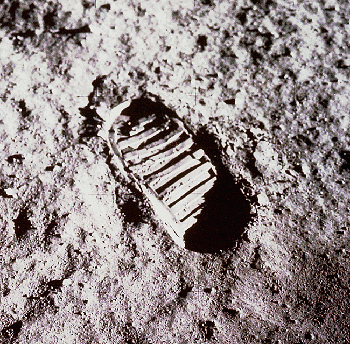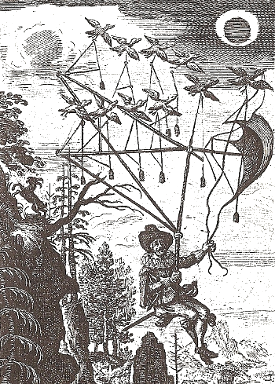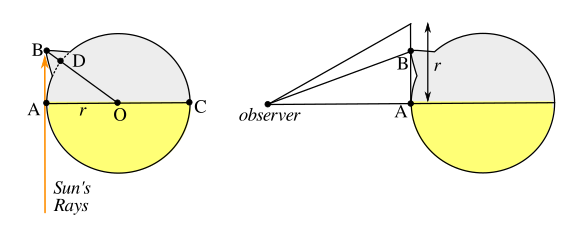Lost Moons
July 15, 2019
This year marks the 50th
anniversary of the first landing of a
manned spacecraft on the
Moon on July 20, 1969, during the
Apollo 11 mission. About 3-1/2 years later,
Apollo astronaut Eugene Cernan (1934-2017) took mankind's last steps on the Moon on December 14, 1972; so, a few years hence will mark the 50th anniversary of man's last presence on the Moon.

Lunar footprint, July 21, 1969.
Astronaut, Edwin Aldrin, of Apollo 11 was the second person to walk on the Moon, following Neil Armstrong (1930-2012) on July 21, 1969.
Aldrin photographed his own footprint in the lunar regolith, demonstrating the mechanical properties of this very fine, dry material.
(Wikimedia Commons image, via NASA.)
It's likely that our
primitive ancestors conjectured about the
nature and purpose of the Moon, but it wasn't until the advent of
written language that such
ideas were shared. While the
Greeks and
Romans associated
deities with the Moon, the
goddess,
Selene, in
Greek mythology and the goddess,
Luna (from which we get the adjective, lunar), in
Roman mythology,
Lucian of Samosata (c.125 - c.180 AD) wrote about the Moon as an abode of
life in his
book,
A True Story (Αληθης Ιστορια).[1-3]
Lucian's works were
popular, and that popularity resulted in the survival of more than eighty of his works.
A True Story was his most popular book, and it's the earliest
science fiction novel.
A True Story includes
space travel and
interplanetary warfare between
alien lifeforms. In the story, Lucian and his
shipmates are blown off
course by a
storm to an
island in which the
trees resemble
women. After this, they are taken by a
whirlwind to the Moon, where the
king of the Moon is attempting to
colonize Venus in competition with the king of the
Sun. A
battle ensues between these alien lifeforms, but a
peace agreement is later reached.

Giant insects are a popular element in science fiction, and the giant spiders in "A True Story" by Lucian of Samosata (c.125 - c.180 AD) are its first instance. (Illustration by Aubrey Beardsley from the 1894 edition of Lucian's, "A True History."[2-3] Click for a larger image.)
As I wrote in an
earlier article (Planetary Biosignatures, March 12, 2018),
German astronomer,
Johannes Kepler (1571-1630) speculated that the
Moon could harbor
extraterrestrial life in his novel,
Somnium, published in 1634 after his
death. Long before
Charles Darwin's ideas of
natural selection, Kepler had the idea that such creatures would have
adapted to the long, cold lunar
nights by
hibernating or developing
hard shells as protection.[4]
Kepler could not imagine any
physical way of reaching the
Moon. It was, instead, described to him by a
daemon who revealed that daemons could at times transport
humans to the Moon. Kepler thought that the distance from the
Earth to the Moon was 50,000
miles, while it's actually about 240,000 miles. Kepler understood the lack of
lunar atmosphere and the
frigid lunar
temperatures. He wrote that humans could
breathe on the Moon through
damp sponges, but they needed to be protected from the cold by the daemons. A
century later,
French mathematician,
Bernard de Fontenelle (1657-1757), wrote a book,
Entretiens sur la Pluralité des Mondes (Conversations on the Plurality of Worlds) in which he assumed that the Moon was lifeless.[4]

Francis Godwin (1562-1633), a bishop of the Church of England, wrote the novel, The Man in the Moone, that was published posthumously in 1638 under a pseudonym.
The frontispiece of the 1659 German edition, shown here, has the unintentional astronaut of this book ascending to the Moon in twelve days through the help of a group of wild swans
Godwin's astronaut finds that the inhabitants of the Moon live in a Utopian society. Homesick after six months on the Moon, he returns to Earth, landing in China.
(Via Wikimedia Commons.)
Cyrano de Bergerac is famous, not just for his
nose, but as the
author of "
The Comical History of the States and Empires of the Moon (L'Autre monde ou les états et empires de la Lune)," which begins,
"After many experiments I constructed a flying machine, and, sitting on top of it, I boldly launched myself in the air from the crest of a mountain. I had scarcely risen more than half a mile when something went wrong with my machine, and it shot back to the Earth. But, to my astonishment and joy, instead of descending with it, I continued to rise through the calm, moonlight air. For three-quarters of an hour I mounted higher and higher. Then suddenly all the weight of my body seemed to fall upon my head. I was no longer rising quietly from the Earth, but tumbling headlong on to the Moon. At last I crashed through a tree, and, breaking my fall among its leafy, yielding boughs, I landed gently on the grass below."[5]
Closer to our own time is the voyage to the Moon depicted in
H. G. Wells' 1901 novel, "
The First Men in the Moon," a story depicted in several
theatrical films starting with a 1919
silent film production.[6-7] The method of
rocket propulsion in this story is the unique
anti-gravity material,
cavorite. Cavorite enables the two principal
male characters to journey to the Moon in a
spherical spaceship that's steered by movable sheets of cavorite. A 1964 film adaptation has an additional
female character.[7]
The idea of women on the Moon was taken to an extreme in the 1953 film,
Cat-Women of the Moon, in which the lunar inhabitants are a
race of women, some named as
letters of the
Greek alphabet (
Alpha,
Beta, and
Lambda).[8] This film is notable for having a
musical score composed by
Elmer Bernstein (1922-2004), who is known also for the score to
The Magnificent Seven. This film, too, has some gigantic spiders. This movie was remade from a slightly different
premise as the 1958
Missile to the Moon.
As our
scientific knowledge of the Moon advanced, so have the
plots in lunar science fiction. While Lucian had a whirlwind bring him to the Moon, and Kepler thought that a journey to the Moon was possible only through the intervention of a
supernatural creature, H.G. Wells imagined a
spacecraft, and the 1950s films featured
rocketry. Lunar
landscapes were fanciful until
Galileo's telescopic observations limited their scope. That's why H.G. Wells imagined the Selenites to be adapted to their harsh
environment and living underground.
Sunil Chebolu, a
professor of
mathematics at
Illinois State University ( Normal, Illinois), has recently revisited Galileo's
estimation of the height of
mountains on the Moon.[10] The
Greek astronomers and their successors didn't believed that there were mountains on the Moon, since they subscribed to the
Aristotelian idea that all
heavenly bodies were perfect
spheres. Galileo's telescopic observations in 1609 showed that the shading of the Moon arose from its
topography, which included mountains.
Galileo realized that at the
first quarter and last quarter lunar phases, the Sun will illuminate the mountain peaks before their sunward terrain on the spherical Moon.[11] Since the Moon's
radius (1737 km) was known to the ancients, simple
geometry and the
Pythagorean theorem are all that are needed to
calculate a lunar mountain's height when this condition is observed. The calculation is illustrated in the following figure.

Measuring lunar mountains. When a mountain peak is just illuminated, a simple calculation will give the mountain's height. (Created using Inkscape. Click for larger image.)
With reference to the figure, if
h is the mountain height and
r is the lunar radius, and
d is the
ratio,
r/|AB|,
h = |OB| - |OD|
h = (|OA|2 + |AB|2)-1/2 - |OD|
h = |OA|(1 + (|AB|2/|OA|2))-1/2 - |OD|
h = r(1 + (|AB|/r)2)-1/2 - r
h = r(1 + (1/d)2)-1/2 - r
The ratio
d is easily obtained by measurement of a
sketch, as Galileo did, or from a
photograph. From his own telescopic observations, Chebolu found a mountain that's 2.39 miles high. For reference,
Mount Everest is 8.848 km (5.5 miles) high, and the highest point on the Moon is 10.786 km (6.7 miles) above the mean radius.[12]
References:
- A Voyage to the Moon: Science Fiction in Ancient Greece, A Classical Blog, August 1, 2015.
- Lucian, "A True Story," Greek text at WikiSource.
- Lucian's True History, Francis Hickes, Trans., 1894, A. H. Bullen Publisher (London, 1902).
- Ron Miller, "Early Ideas About Extraterrestrial Life: What Might Inhabitants from Other Planets Look Like?" ancient-origins.net, November, 17, 2017.
- Sir John Alexander Hammerton and Arthur Mee, Eds., "The World's Greatest Books — Volume 01 — Fiction," from Project Gutenberg.
- The First Men in the Moon, 1919, Bruce Gordon, and J.L.V. Leigh, Directors, on the Internet Movie Database.
- First Men in the Moon. 1964, Nathan Juran, Director, on the Internet Movie Database.
- Cat-Women of the Moon, 1953, Arthur Hilton, Director, on the Internet Movie Database.
- Missile to the Moon, 1958, Richard E. Cunha, Director, on the Internet Movie Database.
- Sunil K. Chebolu, "Measuring Mountains on the Moon," arXiv, May 15, 2019.
- Galileo Galilei, "Sidereus Nuncius," Venice, 1610, Albert Van Helden, Trans., University of Chicago Press (Chicago, Illinois, 1989), PDF file at Reed College Website.
- Highest Point on the Moon, NASA Website, October 27, 2010.
Linked Keywords: Anniversary; Apollo Lunar Module; manned spacecraft; Moon; Apollo 11; Apollo 17; astronaut; Eugene Cernan (1934-2017); lunar; footprint; Edwin Aldrin; Neil Armstrong (1930-2012); photograph; regolith; mechanical property; arid; dry; material; Wikimedia Commons; NASA; prehistory; primitive; ancestor; conjecture; conjectured; teleology; nature and purpose; written language; idea; ancient Greece; Greeks; Roman Empire; Romans; deity; deities; goddess; Selene; Greek mythology; Luna (goddess); Roman mythology; Lucian of Samosata (c.125 - c.180 AD); life; book; A True Story (Αληθης Ιστορια); popularity; popular; science fiction; novel; spaceflight; space travel; interplanetary; war; warfare; extraterrestrial life; alien lifeform; shipmate; navigation; course; storm; island; tree; woman; women; whirlwind; monarch; king; colonization; colonize; Venus; Sun; battle; peace treaty; peace agreement; gigantism; giant; insects; spider; A True Story; Aubrey Beardsley; Germany; German; astronomer; Johannes Kepler (1571-1630); Somnium (novel); death; Charles Darwin; natural selection; adaptation; adapted; night; hibernation; hibernate; exoskeleton; hard shell; physics; physical; daemon (classical mythology); human; Earth; mile; atmosphere of the Moon; lunar atmosphere; cold; frigid; temperature; breathing; breathe; moisture; damp; sponge; century; France; French; mathematician; Bernard de Fontenelle (1657-1757); Francis Godwin (1562-1633); bishop; Church of England; The Man in the Moone; posthumous; pseudonym; book frontispiece; german language; wild swan; Utopian society; homesickness; homesick; China; Cyrano de Bergerac; nose; author; The Comical History of the States and Empires of the Moon; experiment; aircraft; flying machine; mountain; moonlight; weight; human body; head; leaf; leafy; branch; bough; grass; H. G. Wells; The First Men in the Moon; movie theater; theatrical; film; silent film production; spacecraft propulsion; rocket propulsion; anti-gravity; cavorite; male; character (arts); sphere; spherical; spacecraft; spaceship; female; Cat-Women of the Moon; race (human categorization); letter (alphabet); Greek alphabet; Alpha; Beta; Lambda; musical score; composer; compose; Elmer Bernstein (1922-2004); The Magnificent Seven; premise; Missile to the Moon; science; scientific; plot (narrative); supernatural; rocket; rocketry; landscape; Galileo Galilei; telescope; telescopic observation; environment; Sunil Chebolu; professor; mathematics; Illinois State University ( Normal, Illinois); approximation; estimation; ancient Greek astronomy; Greek astronomer; Aristotle; Aristotelian; astronomical object; heavenly body; topography; phases of the Moon; first quarter; last quarter; lunar phase; radius; geometry; Pythagorean theorem; calculation; calculate; Inkscape; ratio; sketch (drawing); photograph; Mount Everest.